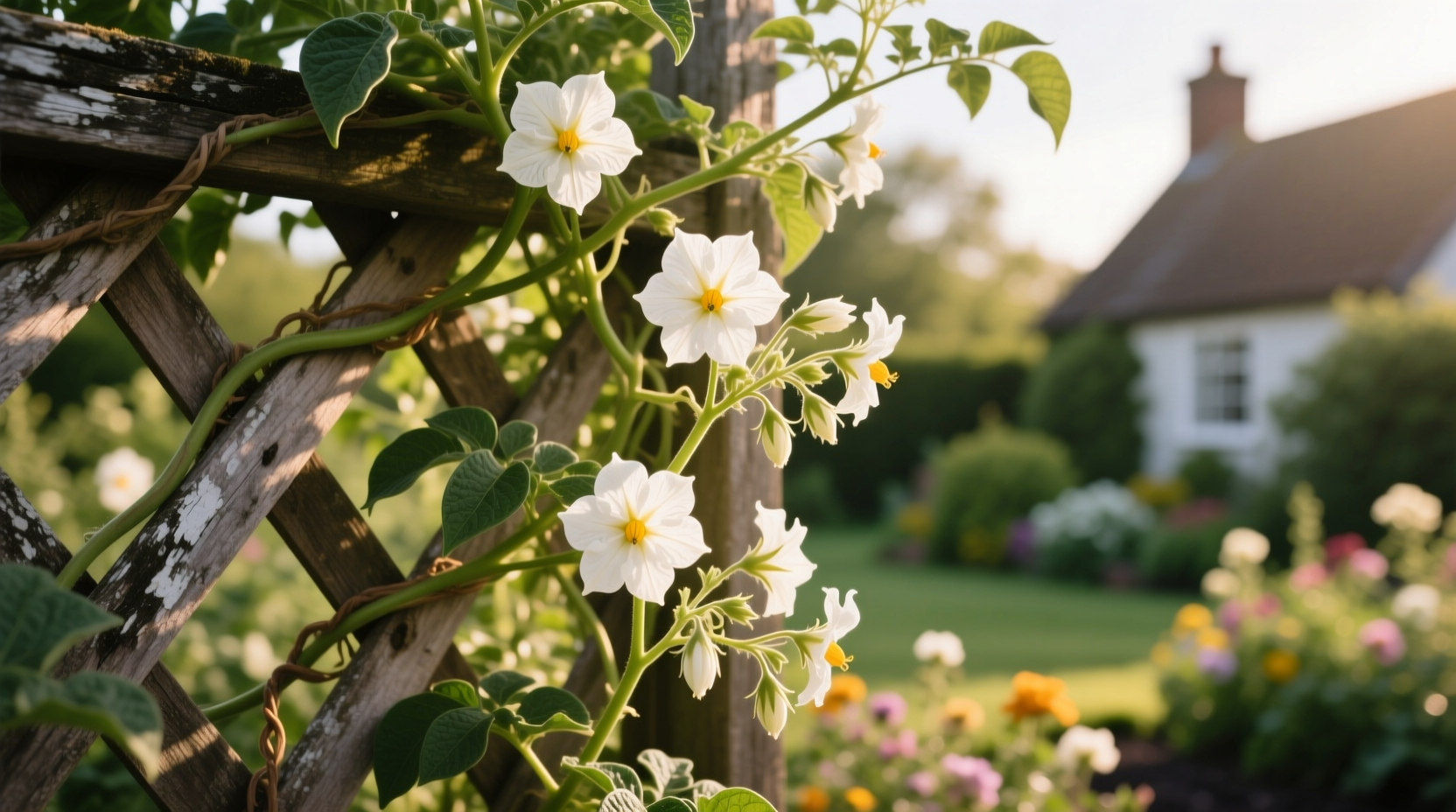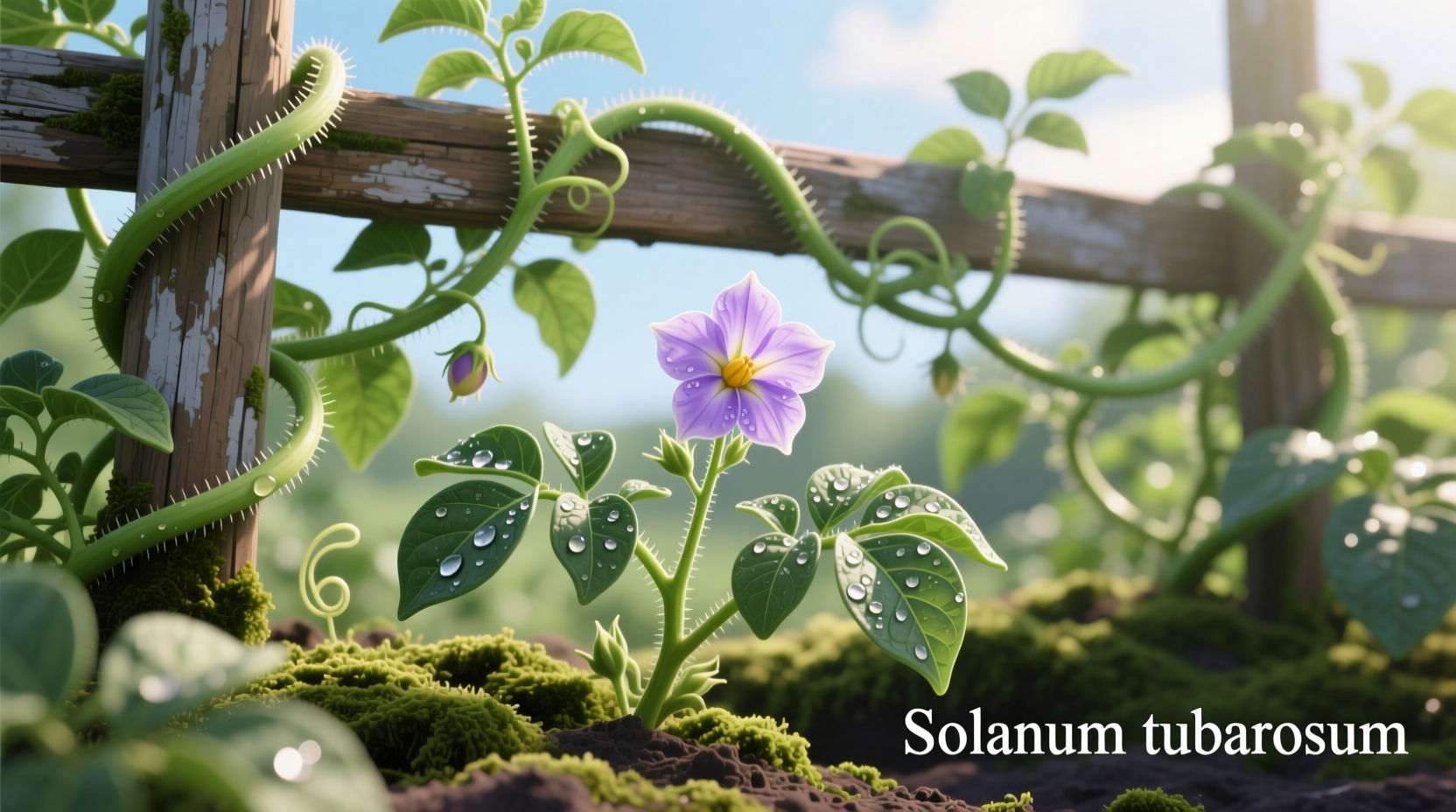If you're searching for information about potato vine, the most critical fact to know immediately is that potato vine (Solanum jasminoides) is not the plant that produces edible potatoes and is actually toxic if consumed. Unlike the common potato (Solanum tuberosum) that grows underground tubers we eat, potato vine is an ornamental climbing plant with white flowers that belongs to the same nightshade family but contains harmful glycoalkaloids throughout its leaves, stems, and berries.
Many gardeners mistakenly believe potato vine produces edible potatoes or is related to sweet potatoes, putting themselves and their families at risk. This comprehensive guide will clarify exactly what potato vine is, how to identify it correctly, and provide essential safety information for homeowners and gardeners.
Understanding Potato Vine: Beyond the Misleading Name
The name "potato vine" creates dangerous confusion. Despite containing "potato" in its common name, this plant (scientifically known as Solanum jasminoides, sometimes labeled as Solanum laxum) produces no edible tubers. It's a flowering vine in the Solanaceae family—the same botanical family as tomatoes, peppers, and eggplants—but critically different from the edible potato plant (Solanum tuberosum).
Native to South America, potato vine was introduced to many regions as an ornamental plant due to its attractive white flowers and vigorous growth habit. University of Florida's Institute of Food and Agricultural Sciences confirms that all parts of the plant contain toxic compounds including solanine and other glycoalkaloids that can cause nausea, vomiting, and neurological symptoms if ingested.
| Feature | Potato Vine (Solanum jasminoides) | Edible Potato Plant (Solanum tuberosum) |
|---|---|---|
| Primary Purpose | Ornamental decoration | Food production |
| Edible Parts | None - all parts toxic | Underground tubers |
| Flowers | White, star-shaped, fragrant | White, pink, or purple (not fragrant) |
| Fruit/Berries | Small green berries turning yellow when ripe (toxic) | Rarely produces berries; if present, toxic |
| Growth Habit | Vigorous climbing vine | Upright or bushy plant |
Why the Confusion Between Potato Vine and Edible Potatoes Persists
The persistent confusion stems from shared botanical classification without shared edibility. Both plants belong to the Solanum genus, but their evolutionary paths diverged significantly. According to research published by the USDA Agricultural Research Service, the toxic compounds in ornamental nightshades like potato vine serve as natural pest deterrents—a defense mechanism not present in the same concentration in cultivated food crops.
This distinction matters tremendously for home gardeners. Many people plant potato vine thinking they're growing an unusual potato variety, only to discover too late that nothing on the plant is safe to eat. The Royal Horticultural Society specifically warns against planting potato vine in areas accessible to children or pets due to the risk of accidental ingestion of the attractive yellow berries.

Growing Potato Vine Safely: Essential Guidelines
If you choose to grow potato vine for its ornamental value, follow these safety-focused practices:
Site Selection and Planting
- Plant away from vegetable gardens to prevent confusion
- Avoid areas where children play or pets roam freely
- Provide sturdy support structures as it can grow 20-30 feet tall
- Best in USDA zones 9-11; can be grown as annual in cooler climates
Care Requirements
Potato vine thrives in full sun to partial shade with well-draining soil. The University of California Cooperative Extension notes that it requires regular watering during establishment but becomes moderately drought-tolerant once established. Unlike edible potatoes, it doesn't require hilling or special soil amendments for tuber production since it doesn't produce edible tubers.
Pruning and Maintenance
Regular pruning helps control this vigorous grower. Wear gloves when handling the plant as some people experience skin irritation from contact with the sap. Remove any berries immediately to prevent accidental ingestion and reduce self-seeding, which can lead to invasive behavior in warm climates.
Safety First: Understanding Potato Vine Toxicity
The most critical information about potato vine concerns its toxicity. According to the American Society for the Prevention of Cruelty to Animals (ASPCA), potato vine is toxic to both humans and animals. All parts contain solanine and other glycoalkaloids that can cause:
- Nausea and vomiting
- Diarrhea
- Headache and dizziness
- In severe cases: neurological symptoms and respiratory distress
Children are particularly at risk because the small yellow berries resemble edible fruits. The National Capital Poison Center reports that most potato vine exposures occur when children mistake the berries for edible fruits. If ingestion occurs, contact poison control immediately (1-800-222-1222 in the US).
Practical Alternatives for Gardeners Seeking Edible Vines
If you're looking for an attractive vine that also produces edible crops, consider these safer alternatives:
- Malabar spinach (Basella alba) - A heat-tolerant vine with edible leaves
- Pea vines - Ornamental flowering peas with edible shoots
- Garden beans - Many pole bean varieties produce attractive flowers
- Chayote squash - Produces edible fruit and attractive foliage
These alternatives provide the visual appeal of a climbing vine without the safety risks associated with potato vine. Unlike potato vine, these plants have edible components that won't cause poisoning when consumed as intended.
When Potato Vine Might Be Appropriate for Your Garden
Despite the risks, potato vine has legitimate ornamental value in certain situations:
- As a screen for unsightly structures in adult-only gardens
- In botanical collections with proper labeling
- As a cut flower source (with careful handling)
- In regions where it won't become invasive
The key is understanding the context boundaries. The California Invasive Plant Council classifies potato vine as having moderate invasive potential in coastal California. Before planting, check with your local extension service about its status in your area.
Identifying Potato Vine: Key Characteristics
Learn to recognize potato vine by these distinctive features:
- Leaves: Glossy, dark green, oval-shaped with pointed tips (2-4 inches long)
- Flowers: White, star-shaped (1 inch diameter), fragrant, appearing in clusters
- Fruit: Small round berries that start green and turn yellow when ripe
- Stems: Thin, flexible, with a climbing/vining growth habit
- Roots: Fibrous system without edible tubers
Remember that young potato vine plants may resemble edible potato plants, making accurate identification crucial before any part is considered for consumption.
Common Misconceptions About Potato Vine
Several persistent myths about potato vine need clarification:
- Myth: Potato vine produces small edible potatoes
Fact: It produces no edible tubers whatsoever - Myth: The leaves or berries are safe to eat in small quantities
Fact: All parts are toxic; even small amounts can cause illness - Myth: It's the same as sweet potato vine
Fact: Sweet potato vine (Ipomoea batatas) is a different plant entirely and has edible tubers - Myth: Cooking destroys the toxins
Fact: Glycoalkaloids remain stable through cooking
These misconceptions contribute to dangerous situations, particularly when foragers mistake potato vine for edible plants. The North Carolina State University Extension emphasizes that proper plant identification is essential before consuming any wild or garden plant.
Responsible Disposal of Potato Vine
If you need to remove potato vine from your property, follow these safety guidelines:
- Wear gloves and long sleeves to prevent skin contact
- Bag all plant material securely before removal
- Do not compost potato vine material
- Dispose of in household trash, not green waste collection
- Wash tools thoroughly after handling
Improper disposal can lead to accidental exposure or spread of the plant to areas where children might encounter it. The Oregon State University Extension specifically warns against burning potato vine as the smoke can carry irritants.
Final Thoughts: Making Informed Garden Choices
Understanding the reality of potato vine—what it is, what it isn't, and the risks it presents—helps you make safer choices for your garden. While its attractive flowers and vigorous growth make it appealing, the potential dangers outweigh the benefits for most home garden situations, especially those with children or pets.
When selecting plants for your garden, always verify both the common and scientific names, research toxicity information from reliable sources, and consider your specific household circumstances. The American Horticultural Society recommends consulting multiple authoritative sources before introducing any new plant to your landscape, particularly those with potentially toxic properties.











 浙公网安备
33010002000092号
浙公网安备
33010002000092号 浙B2-20120091-4
浙B2-20120091-4